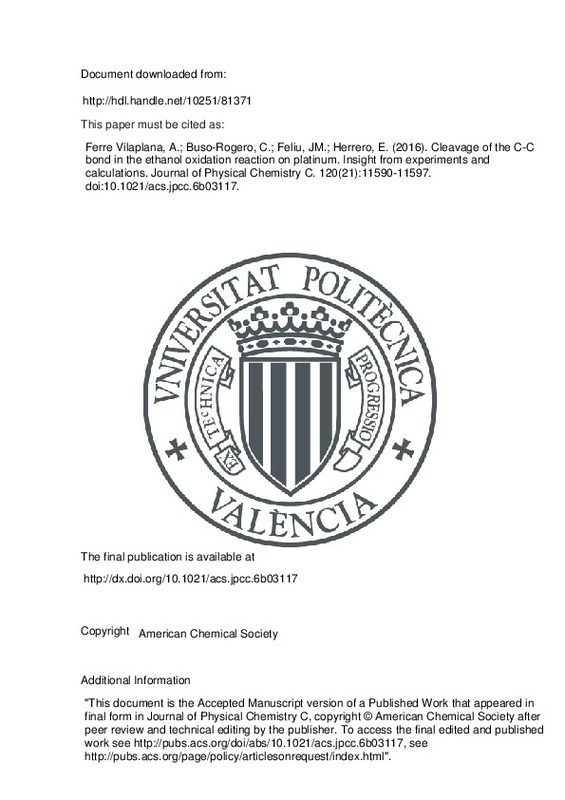Ferre Vilaplana, A.; Buso-Rogero, C.; Feliu, JM.; Herrero, E. (2016). Cleavage of the C-C bond in the ethanol oxidation reaction on platinum. Insight from experiments and calculations. Journal of Physical Chemistry C. 120(21):11590-11597. https://doi.org/10.1021/acs.jpcc.6b03117
Por favor, use este identificador para citar o enlazar este ítem: http://hdl.handle.net/10251/81371
|
Título:
|
Cleavage of the C-C bond in the ethanol oxidation reaction on platinum. Insight from experiments and calculations
|
|
Autor:
|
Ferre Vilaplana, Adolfo
Buso-Rogero, Carlos
Feliu, Juan M.
Herrero, Enrique
|
|
Entidad UPV:
|
Universitat Politècnica de València. Escuela Politécnica Superior de Alcoy - Escola Politècnica Superior d'Alcoi
Universitat Politècnica de València. Instituto Universitario Mixto Tecnológico de Informática - Institut Universitari Mixt Tecnològic d'Informàtica
Universitat Politècnica de València. Departamento de Sistemas Informáticos y Computación - Departament de Sistemes Informàtics i Computació
|
|
Fecha difusión:
|
|
|
Resumen:
|
[EN] Using a combination of experimental and computational methods, mainly FTIR and DFT calculations, new insights are provided here in order to better understand the cleavage of the C–C bond taking place during the complete ...[+]
[EN] Using a combination of experimental and computational methods, mainly FTIR and DFT calculations, new insights are provided here in order to better understand the cleavage of the C–C bond taking place during the complete oxidation of ethanol on platinum stepped surfaces. First, new experimental results pointing out that platinum stepped surfaces having (111) terraces promote the C–C bond breaking are presented. Second, it is computationally shown that the special adsorption properties of the atoms in the step are able to promote the C–C scission, provided that no other adsorbed species are present on the step, which is in agreement with the experimental results. In comparison with the (111) terrace, the cleavage of the C–C bond on the step has a significantly lower activation energy, which would provide an explanation for the observed experimental results. Finally, reactivity differences under acidic and alkaline conditions are discussed using the new experimental and theoretical evidence.
[-]
|
|
Palabras clave:
|
Single-crystal electrodes
,
Electrochemical mass-spectrometry
,
Surface-structure
,
Stepped surfaces
,
Adsorption
,
Electrooxidation
,
Ftir
,
Polycrystalline
,
Density
,
Acid
|
|
Derechos de uso:
|
Reserva de todos los derechos
|
|
Fuente:
|
Journal of Physical Chemistry C. (issn:
1932-7447
) (eissn:
1932-7455
)
|
|
DOI:
|
10.1021/acs.jpcc.6b03117
|
|
Editorial:
|
American Chemical Society
|
|
Versión del editor:
|
http://dx.doi.org/10.1021/acs.jpcc.6b03117
|
|
Código del Proyecto:
|
info:eu-repo/grantAgreement/MINECO//CTQ2013-44083-P/ES/ESTUDIOS AVANZADOS SOBRE LA REACCION DE REDUCCION DE OXIGENO/
info:eu-repo/grantAgreement/GVA//PROMETEOII%2F2014%2F013/
|
|
Descripción:
|
"This document is the Accepted Manuscript version of a Published Work that appeared in final form in Journal of Physical Chemistry C, copyright © American Chemical Society after peer review and technical editing by the publisher. To access the final edited and published work see http://pubs.acs.org/doi/abs/10.1021/acs.jpcc.6b03117, see http://pubs.acs.org/page/policy/articlesonrequest/index.html".
|
|
Agradecimientos:
|
This work has been financially supported by the MINECO (Spain) (project CTQ2013-44083-P) and Generalitat Valenciana (project PROMETEOII/2014/013).
|
|
Tipo:
|
Artículo
|







![[Cerrado]](/themes/UPV/images/candado.png)

